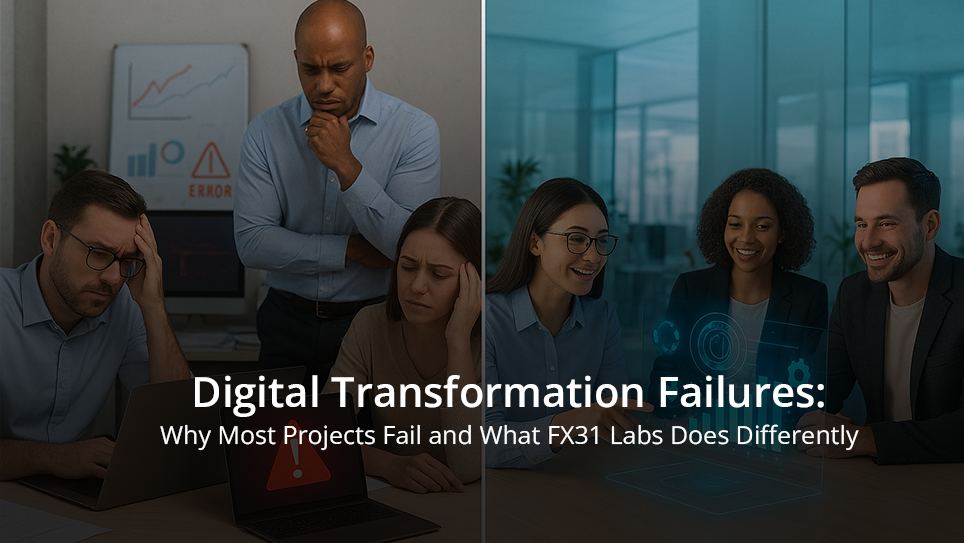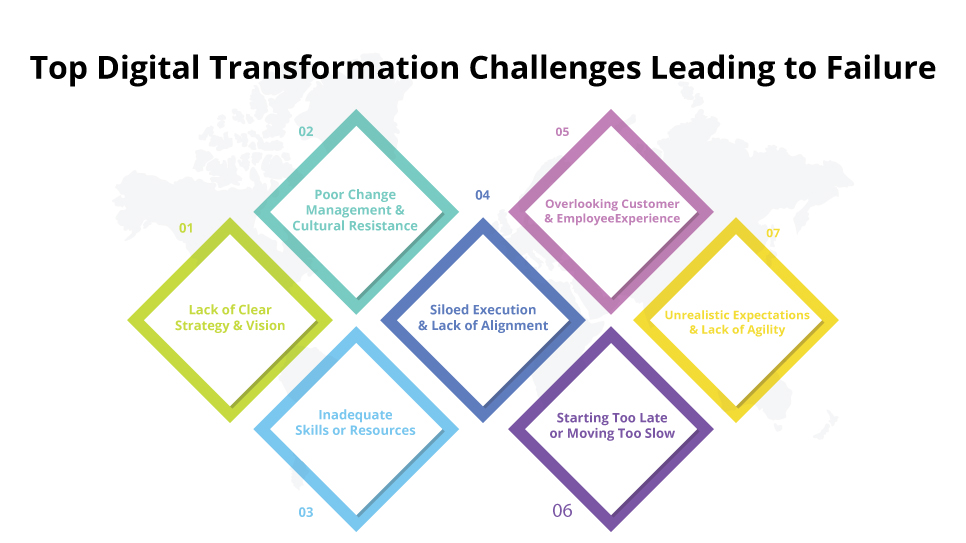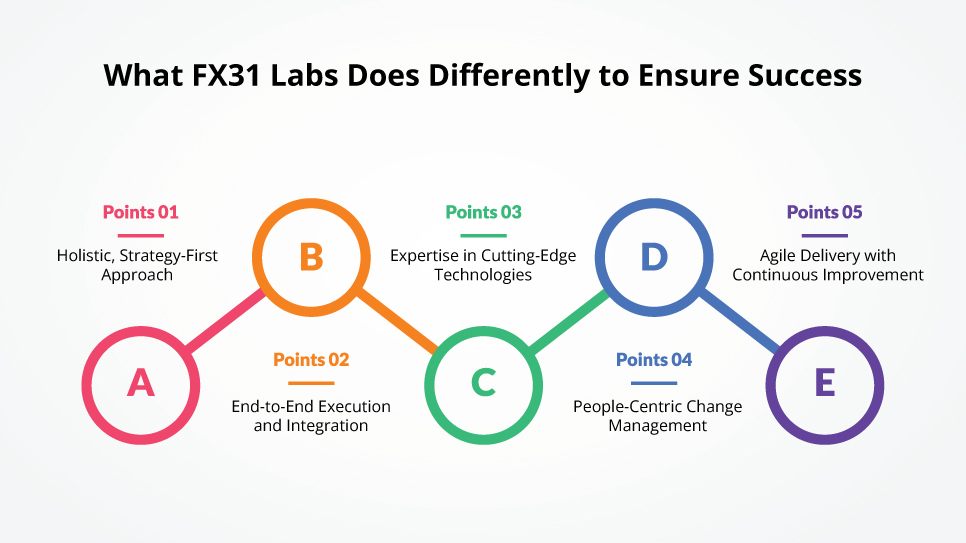Digital Transformation Failures: Why Most Projects Fail and What FX31 Labs Does Differently

Digital transforms, despite companies pouring billions into ambitious initiatives. Research often cites that around 70% of digital transformations end up failing to meet their goals. In 2018 alone, companies spent an estimated $1.3 trillion on digital initiatives, and astonishingly, about $900 billion of that was wasted on digital transformation failures. These sobering statistics underscore a crucial reality: undertaking a digital transformation is challenging, and failure has become more common than success.
So, why do so many digital transformation projects fail despite the best intentions? And importantly, what can be done differently to beat the odds? This blog delves into the core reasons behind digital transformation failures and reveals how FX31 Labs approaches digital transformation in a way that avoids these common pitfalls. By learning from past failures and adopting a smarter strategy, your organization can join the ranks of the successful digital transformers instead of becoming another cautionary tale.
What You’ll Learn: In this blog, we’ll explore:
- The real reasons why digital transformation fails so often include the common challenges and pitfalls that derail projects.
- Real-world examples of digital transformation failures (Ford, Sears, Kodak) and the lessons they teach us about what not to do.
- Key challenges in digital transformation, from cultural resistance to lack of strategy, and how to overcome these hurdles.
- How to build a successful digital transformation strategy, including best practices that dramatically improve your chances of success.
- What FX31 Labs does differently in its approach to digital transformation, and how those differences help ensure projects succeed where others fail.
By the end of this post, you’ll understand the primary causes of digital transformation failures and gain insights into crafting a strategy that works, the same principles FX31 Labs uses to consistently deliver successful transformation outcomes.
Top Digital Transformation Challenges Leading to Failure

Why do so many transformations fall short? The reasons why digital transformation fails are usually not due to the technology itself, but rather due to organizational and strategic challenges. Understanding these failure points is the first step to avoiding them. Here are some of the most common challenges and pitfalls that lead to digital transformation failures:
- Lack of Clear Strategy & Vision: One of the leading causes of digital transformation failures is the absence of a well-defined strategy. Some organizations jump into digital initiatives without a clear vision of why they are transforming and what specific outcomes they seek. This can lead to misaligned projects that don’t solve real business problems.
- Poor Change Management & Cultural Resistance: Digital transformation is as much about people and processes as it is about technology. A frequent reason why digital transformation projects fail is resistance from employees and a company culture that doesn’t embrace change.
- Inadequate Skills or Resources: Another common digital transformation challenge is not having the right talent or expertise to execute the vision. Implementing cutting-edge technologies (like AI, advanced analytics, cloud platforms, or robotics) often requires specialized skill sets. Many companies underestimate the need for training or hiring, and projects fail because teams simply can’t build or integrate the new systems properly.
- Siloed Execution & Lack of Alignment: Digital transformations span the entire enterprise, and they affect multiple departments from IT and operations to marketing and customer service. If initiatives are executed in silos (for instance, only within IT without business unit collaboration), they often fail. A new CRM or ERP system that isn’t embraced company-wide or doesn’t integrate with other systems will not yield its intended benefits.
- Overlooking Customer & Employee Experience: Every successful digital transformation ultimately aims to provide better value, often through superior customer experience or improved employee productivity. When projects are designed in a vacuum without input from end-users, they can flop due to low adoption.
- Starting Too Late or Moving Too Slow: In contrast to moving with no strategy, some companies fail by waiting too long to transform or reacting too slowly to market changes.
- Unrealistic Expectations & Lack of Agility: Finally, many digital transformation initiatives fail due to unrealistic expectations and rigid planning. Transforming an enterprise is complex; it rarely goes exactly as planned. If leadership expects overnight success or sets unattainable goals (e.g., 10x efficiency improvement in a year), the project team is set up to look like a failure.
Digital transformation challenges are multi-faceted, spanning strategy, culture, skills, execution, and mindset. Even industry leaders have stumbled. Consider Kodak’s famous failure: despite inventing the first digital camera, Kodak’s leadership hesitated to fully embrace digital technology for fear of cannibalizing their film business. By the time they acted, rivals had seized the digital market, and Kodak’s late, half-hearted transformation led to bankruptcy. The Kodak story highlights how clinging to old business models and resisting disruptive technology can doom a company’s future.
How to Build a Successful Digital Transformation Strategy
Given the high failure rates, how can your organization stack the odds in favor of success? The answer lies in building a successful digital transformation strategy that incorporates lessons from past failures. Here are some best practices and pillars of a strategy to ensure your digital transformation not only survives but thrives:
- Start with a Clear Vision and Business Alignment: Every successful digital transformation strategy begins by answering, “What does success look like for our business?” Define concrete goals tied to business outcomes
- Secure Executive Sponsorship and Cross-Functional Buy-In: Transformation must be driven from the top and embraced across the company. Ensure you have strong executive sponsorship, leaders who actively champion the change, allocate resources, and remove roadblocks.
- Invest in People, Skills, and Change Management: Remember that digital transformation isn’t just about technology; it’s about people. Prepare your workforce for change through robust change management practices. This includes transparent communication about why the transformation is happening and how it benefits everyone, as well as training programs to upskill employees on new tools and processes.
- Prioritize Customer-Centric and Employee-Centric Design: Keep the end-user in mind for every digital initiative. Whether it’s an internal system or a customer-facing app, design solutions that genuinely solve users’ pain points and are easy to adopt. Gather feedback through surveys, user testing, or pilot programs to ensure the new digital process improves the experience.
- Think Big, Start Small, and Iterate: Plot a long-term digital roadmap but implement in manageable phases. Break the transformation into smaller projects or pilots that can deliver quick wins. Early successes (even minor ones) build momentum, justify the investment, and provide learning opportunities to refine your approach.
- Leverage the Right Technology (Wisely): A successful strategy involves selecting technology solutions that fit your company’s needs, not just chasing buzzwords. Carefully evaluate which technologies will truly drive your strategic goals. For instance, if improving data-driven decision making is a goal, you might invest in analytics and AI platforms.
- Bring in Expertise and Partners When Needed: Not every organization has all the required expertise in-house, and that’s okay. A wise strategy is to partner with experienced digital transformation experts or services to fill gaps. For example, if your team lacks deep cloud or AI experience, collaborating with a specialized firm or consultants can accelerate your project and help you avoid missteps.
In essence, building a successful digital transformation strategy means being strategy-driven, people-focused, agile, and well-supported. Companies that follow these principles dramatically improve their odds of success. They transform with purpose, carry their people along, adapt to change, and utilize expertise where it counts. This is exactly how FX31 Labs approaches digital transformation for its clients, as we’ll discuss next.
What FX31 Labs Does Differently to Ensure Success

Many consulting firms and vendors offer help with digital transformation, but FX31 Labs stands out by addressing the very challenges that cause most digital transformation failures. FX31 Labs is not just an implementer of technology; it acts as a strategic partner that guides organizations from the initial idea to successful execution and adoption. Here are some key ways FX31 Labs does things differently, leading to consistently successful digital transformation outcomes:
- Holistic, Strategy-First Approach: From day one, FX31 Labs emphasizes understanding your business goals and crafting a clear transformation roadmap. Rather than jumping straight into tech deployment, their experts work with your leadership to define a strategic vision with measurable outcomes. Every initiative is aligned with business KPIs, ensuring that the digital solutions delivered move the needle for your organization.
- End-to-End Execution and Integration: FX31 Labs differentiates itself by providing support across the full lifecycle of transformation, from design and development to integration, deployment, and ongoing optimization. This end-to-end involvement is crucial because one-off solutions often fail if not integrated properly into the business. FX31 Labs’ team covers every layer: they design custom software solutions tailored to your workflows, develop and test the solutions thoroughly, and then integrate them seamlessly into your existing environment.
- Expertise in Cutting-Edge Technologies: One thing that sets FX31 Labs apart is its deep bench of expertise in emerging technologies, including AI, machine learning, IoT, and robotics. This means clients get access to specialists who know how to leverage these tools effectively. For instance, FX31 has dedicated teams for agentic AI enterprise transformation and advanced automation. They understand how to implement autonomous, context-aware AI agents into enterprise workflows. Similarly, FX31 offers in-house Robotics Development Services for companies looking to automate physical processes or develop smart devices, as well as custom software development services for building any bespoke applications needed.
- People-Centric Change Management: FX31 Labs understands that successful transformation is not just about delivering a new system, but also about getting your people to embrace it. As part of their process, they help clients develop robust change management and training plans. Whether it’s conducting workshops to get stakeholder buy-in, providing user training sessions, or iterating on the solution based on employee feedback, FX31 actively works to smooth the human side of the transition.
- Agile Delivery with Continuous Improvement: Unlike some consultancies that deliver a solution and disappear, FX31 Labs follows an agile, iterative delivery model. Projects are broken into sprints or phases with clear milestones, and there is continuous evaluation at each step. This means if requirements change or new insights emerge, the plan adapts, preventing the project from derailing. Even after initial deployment, FX31 stays involved to monitor performance, measure results against targets, and make improvements.
In summary, FX31 Labs mitigates the usual failure points by combining strategic planning, technical excellence, integration know-how, change management, and agile execution. This comprehensive approach is what FX31 Labs does differently, and it’s why their clients’ digital transformation initiatives succeed more often than the norm. Where many projects falter due to gaps in strategy, culture, or expertise, FX31 Labs fills those gaps and guides the project through to a positive result.
Conclusion
Digital transformation doesn’t fail because of bad technology. It fails when there’s no clear direction, when teams aren’t aligned, or when change feels disconnected from real business needs.
That’s exactly where FX31 Labs comes in.
We don’t just deliver digital systems, we help build the strategy, structure, and team alignment that ensures transformation sticks. From rethinking your workflows to designing future-ready architectures and embedding agentic AI enterprise transformation capabilities, our focus is on execution that works in the real world.
If you’re re-evaluating an underperforming digital initiative or gearing up for a fresh transformation push, let’s talk. Our custom software development services and robotics development expertise aren’t just buzzwords; they’re built for business outcomes.
With FX31 Labs, transformation isn’t a gamble. It’s a guided process, with clarity, impact, and momentum from day one.
FAQs
1. Why do most digital transformation projects fail?
Most digital transformations fail not because of poor technology, but due to lack of strategy, poor change management, siloed execution, and cultural resistance. Without a clear roadmap and cross-functional alignment, even the best tools can fall short.
2. What are the biggest challenges in digital transformation?
Key challenges include:
- Lack of executive sponsorship
- Employee resistance to change
- Poor integration between systems
- Lack of digital skills or technical expertise
- Unrealistic expectations around speed and outcomes
These are all common reasons why digital transformation fails across industries.
3. What makes FX31 Labs different from other digital transformation companies?
Unlike traditional consultants, FX31 Labs blends strategy, software engineering, agentic AI enterprise transformation, and team alignment into a single agile workflow. Our work doesn’t stop at launch—we continuously optimize for business results.
4. What is a successful digital transformation strategy?
A successful strategy ties digital initiatives to measurable business outcomes. It involves phased implementation, customer-centric design, leadership buy-in, and continuous feedback loops. The strategy must adapt as the business evolves.
5. How does FX31 Labs help reduce digital transformation failure risk?
FX31 Labs follows a strategy-first approach. We provide:
- Custom software development
- Robotics development services
- AI and automation integration
- End-to-end execution and change management
This ensures projects are aligned, agile, and outcome-focused from day one.
